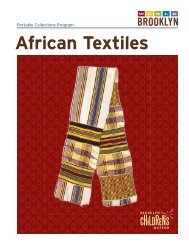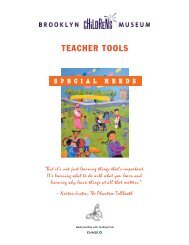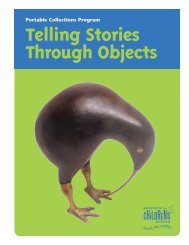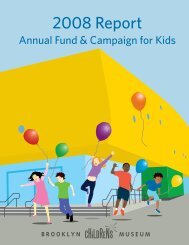What Are Masks For? - Brooklyn Children's Museum
What Are Masks For? - Brooklyn Children's Museum
What Are Masks For? - Brooklyn Children's Museum
Create successful ePaper yourself
Turn your PDF publications into a flip-book with our unique Google optimized e-Paper software.
■ INFORMATION FOR THE TEACHER ■<br />
Behind the Mask (continued)<br />
When used in plays and performances, masks provide<br />
their wearers with a way to hide their identities.<br />
However, you don’t have to be an actor in order to<br />
pretend to be somebody else for a while. Many cultures<br />
have a rich tradition of masquerades (masked<br />
parties or celebrations). <strong>For</strong> example, masks are an<br />
important element in the pre-Lenten Carnival or<br />
Mardi Gras festivals held in Venice, Rio de Janeiro,<br />
New Orleans, and many places in the Caribbean.<br />
Besides work and play, masks can also serve a spiritual<br />
purpose. In some cultures, masks provide a way of<br />
communicating with the spirits during religious ceremonies<br />
and rituals. There are several examples of<br />
this among the masks in the case. The Northwest<br />
Coast mask in the case is decorated with the images<br />
of spirit helpers, animals whose spirits were believed<br />
to give strength to the wearer during a healing<br />
ceremony. The baba mask from Papua New Guinea<br />
would be worn during initiation ceremonies for a<br />
secret society, and represents the spirits who act as<br />
go-betweens for the world of the living and the<br />
world of the dead.<br />
Some masks have a purpose that blurs the line<br />
between theatrical and cultural performances and<br />
spiritual rituals. <strong>For</strong> example, the Gägon mask in the<br />
case represents the hornbill, a bird that the Dan<br />
people of West Africa believe was the first creature<br />
God ever created. When a person wearing the Gägon<br />
mask dances during a ceremony, it entertains the<br />
audience and makes people laugh. It also makes<br />
them remember the hornbill creation story. But<br />
most importantly of all, this masked performance is<br />
believed to bring the spirit of Gägon down among<br />
them. <strong>For</strong> the Dan people, a mask is able to embody<br />
the very spirit of the thing it represents.<br />
<strong>For</strong> some people masks are just ordinary objects, but<br />
for others they hold great spiritual power. So when<br />
teaching your students about the masks in the case,<br />
encourage them to show respect for these masks,<br />
particularly in the way they handle and talk about<br />
them.<br />
<strong>Masks</strong> in our everyday lives<br />
Although it may not be immediately obvious to your<br />
students, masks are a part of their daily lives in the<br />
United States, just as they are for people in other parts<br />
of the world. As discussed above, some people here<br />
wear masks as part of their jobs, whether for physical<br />
protection or for the purposes of a theatrical<br />
performance.<br />
<strong>Masks</strong> can be an important part of American holidays<br />
and celebrations, too. <strong>For</strong> example, people may host<br />
masked parties, or hold festivals like Mardi Gras in<br />
New Orleans (as discussed above). Most commonly,<br />
every Halloween many children dress up in masks<br />
and costumes. This is a very old tradition. The Druids<br />
of ancient Britain believed that October 31 was the<br />
night witches and goblins haunted the evening sky.<br />
Christians adopted this same night as All Hallows Eve,<br />
and believe that this is the evening the souls of the<br />
dead revisit their former homes. Originally people<br />
dressed up as witches and goblins on October 31 in<br />
order to disguise themselves from supernatural<br />
beings. Today, though, this custom has grown to<br />
include all sorts of costumes and masks, from ghosts<br />
and skeletons to famous people and cartoon<br />
characters. ❑<br />
Words in boldface have been included in the Vocabulary<br />
Words section on page 15.<br />
MASKS 4








